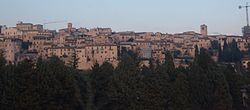Spello
| Spello | ||
|---|---|---|
| Comune | ||
| Comune di Spello | ||

The Porta di Venere (Venus' Gate), from the 1st century BC. It has two dodecagonal towers called "Propertius' Towers".
|
||
|
||
| Location of Spello in Italy | ||
| Coordinates: 42°59′N 12°40′E / 42.983°N 12.667°ECoordinates: 42°59′N 12°40′E / 42.983°N 12.667°E | ||
| Country | Italy | |
| Region | Umbria | |
| Province / Metropolitan city | Perugia (PG) | |
| Frazioni | Collepino, San Giovanni, Limiti, Acquatino, Capitan Loreto | |
| Government | ||
| • Mayor | Sandro Vitali (since June 13, 2004) | |
| Area | ||
| • Total | 61 km2 (24 sq mi) | |
| Elevation | 280 m (920 ft) | |
| Population (2007) | ||
| • Total | 8,585 | |
| • Density | 140/km2 (360/sq mi) | |
| Demonym(s) | Spellani | |
| Time zone | CET (UTC+1) | |
| • Summer (DST) | CEST (UTC+2) | |
| Postal code | 06038 | |
| Dialing code | 0742 | |
| Patron saint | St. Felix | |
| Saint day | May 18 | |
| Website | Official website | |
Spello (in Antiquity: Hispellum) is an ancient town and comune (township) of Italy, in the province of Perugia in east central Umbria, on the lower southern flank of Mt. Subasio. It is 6 km (4 mi) NNW of Foligno and 10 km (6 mi) SSE of Assisi.
The old walled town lies on a regularly NW-SE sloping ridge that eventually meets the plain. From the top of the ridge, Spello commands a good view of the Umbrian plain towards Perugia; at the bottom of the ridge, the town spills out of its walls into a small modern section (or Borgo) served by the rail line from Rome to Florence via Perugia.
Populated in ancient times by the Umbri, it became a Roman colony in the 1st century BC. Under the reign of Constantine the Great it was called Flavia Constans, as attested by a document preserved in the local Communal Palace.
The densely inhabited town, built of stone, is of decidedly medieval aspect, and is enclosed in a circuit of medieval walls on Roman foundations, including three Roman Late Antique gates (Porta Consolare, Porta di Venere and the "Arch of Augustus") and traces of three more, remains of an amphitheater, as well several medieval gates. Spello boasts about two dozen small churches, most of them medieval: the most important are:
Other points of interest include:
In the plain, near S. Claudio, are the remains of a semi-excavated Roman amphitheater; and a small valley to the east of the town is remarkable for its traces of Roman centuriation.
Beyond the town proper, the comune's chief monuments are the church of San Silvestro at Collepino, and the church of the Madonna della Spella with late-medieval votive frescoes and graffiti.
Since 2008 Spello has also a pact of friendship with Accadia, Italy.
View of the town
Infiorata 2004
Infiorata 2006
...
Wikipedia


